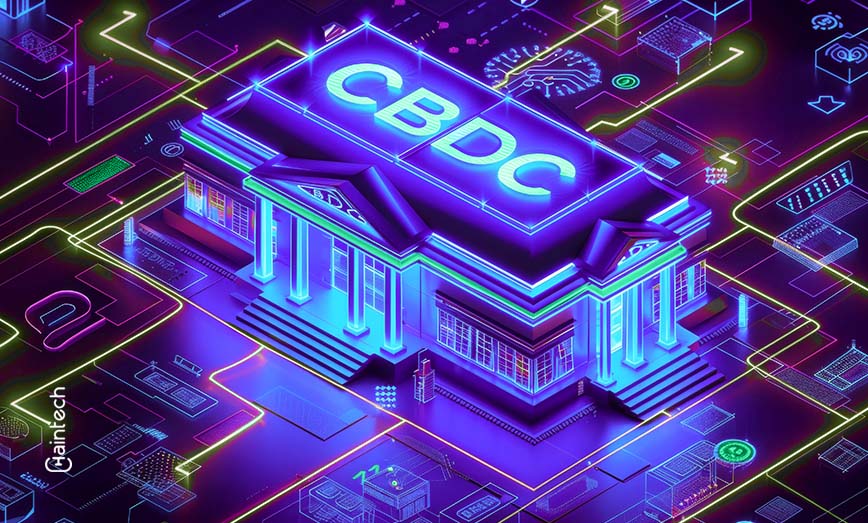What is CBDC? A Beginner’s Guide

Have you ever lived in a cashless world? Consider a situation where all modes of payment are made through orders or other mentioned means, and no one uses cash at all. Central Bank digital currencies, or CBDC, address this problem.
Most countries are embracing CBDCs as their new legal tender. But what are CBDCs, and how do they function?
CBDC Cryptocurrencies In the form of Stable Coins
- A central bank digital currency is an electronic note issued by a country’s central bank that binds itself to the central monetary liabilities of a particular currency system.
- It is this nature of Cbdc that makes it possible to distinguish it from Bitcoin and the varied stable coins among them; it remains constant since it has the government behind it.
- CBDCs that could encourage population growth and provide low operational and administrative costs may have privacy and cyber safety risks.
So, let’s explore CBDC’s definition, why it is important, and what problems it brings.
What is CBDC? Definition of CBDC
Central Bank Digital currency is a material dimension of any country’s legal tender, like the dollar or euro. The central bank directly issues it. Imagine it as virtual cash currencies.
Bitcoin and other infamous floating cryptocurrencies have come under attack for too much instability. Contrary to that, a certain currency within the state should be implemented.
Several nations are working with CBDCs to enhance their financial systems. These digital currencies are not to be considered a replacement for physical cash, at least not now, but they serve as a better and more convenient version of money.
In conjunction with CBDCs, central banks can now conduct transactions more efficiently within borders and in other countries.
Why Are They Important?
As a result, central banks have shifted their attention towards introducing CBDCs to achieve greater financial inclusion, including within the unbanked segments of the population. It is well known that even within the great wealth of the U.S., there are many places where people never use or do not have bank services. In such cases, CBDCs could help because they are simple and secure money that allows its owner to make transactions.
And this is why CBDCs are important and of any relevance at all:
- Financial inclusion: Many people don’t have access to banks. Many people don’t have access to banks. Most people put their money in more expensive, risky, unregulated financial institutions to keep their funds. Using CBDCs can make that easier and safer.
- Reduction of transaction charges: Transaction charges can be removed with the use of CBDCs since no or minimum fixed fees will be charged while sending money securely.
- Safe and stable: Government-issued digital currencies are safe, unlike volatile cryptocurrencies such as Bitcoin, which appreciate and depreciate depending on market forces.
- Increased control: Central banks possess a currency system monopoly provoked by CBDC usage and help implement monetary policy control, assuring a stable economy.
Did you know?
In 2020, the Bahamas was recognized as the first country to roll out a Central Bank digital currency called the sand dollar.
Differences between the wholesale CBDCs and the retail CBDCs
Generally, CDBCs fall within two broad categories: wholesale CDBCs and cryptocurrency CDBCs. Let’s look deeper into the purpose of each type of CDBC.
- Wholesale CDBCs: These are used in the bulk transactions carried out by banks and financial institutions in given economies. They operate more like the bank channels post-backs, connecting almost all the areas where payments need to be made and interbank transactions occur.
- Retail CDBCs: This form of digital currency targets the common person who uses it for basic activities such as making purchases and settling utility bills.
Retail CBDCs refer to cashless cryptocurrencies that many people and corporations can access and utilize to further their monetary needs.
There are two subtypes of retail CBDCs:
- Token-based: This CBDC can also be sequentially described as another type of money in which no information is required to perform the transaction.
- Account-based: This simply describes the customer requirements and the function that comes with the accounting system.
Here’s a quick comparison of the two:
| CBDC Type | Main Users | Purpose |
| Wholesale CBDC | Banks, financial institutions | Interbank transfers, large transactions |
| Retail CBDC | Consumers, businesses | Everyday transactions, paying bills |
| Token-based CBDC | Consumers, businesses | Anonymous transactions, like digital cash |
| Account-based CBDC | Consumers, businesses | Identity-tied transactions, like a bank account |
How Are CBDCs Different from Cryptocurrencies?
Attitudes towards CBDCs and cryptocurrencies are at times mistaken as the same conclusion although it is not a case in a true sense. Since cryptocurrencies function without the intervention of the central bank such as in Bitcoin, this contributes to the great level of price fluctuation. Such is not the case for CBDCs, which are controlled on a leash by the central banks.
Here is what is different between the two:
- Control: A central bank controls the operations of CBDCs, while no central authority governs the operation of cryptocurrencies.
- Stability: Volatility is a characteristic feature of cryptocurrencies since the whim of the market determines their worth. This gives room for the development of a normal economy within which the normal country’s currency ties CBDCs.
- Technology: CBDCs can be placed over the blockchain infrastructure, but this is not a uniform rule for all CBDCs. Consensus mechanisms can be used in various cryptocurrencies and the most common would include Proof of Work/Proof of Stake.
The Challenges of Implementing CBDCs
Though the adoption of CBDCs seems beneficial to the economy, many factors need to be considered optimally before placing them in public use. Let us highlight only a few such factors in a bit more detail:
- Financial Stability: The introduction of a CBDC also has repercussions on the whole system, with the risk of upheavals in the multilateral financial system. One risk in this case is when many people move from the comfort of their bank’s deposits to CBDCs.
- Privacy Issues: Unlike cash, CBDCs may afford governments the ability to reconcile many transactions, which can raise fears about privacy.
- Cybersecurity: Like any other digital system, Central Bank Digital Currency is also at risk of being hacked. Users will need such security measures to deter theft and fraud.
- Impact on Banks: If everybody started holding CBDCs rather than putting money in banks, it could also change how banks make loans, impact the level of interest rates, and affect the economy.
Some easy answers need to be found to such problems so that CBDCs do not cause aggravation to all and sundry.
Did you know?
CBDCs are not issued through mining, as in the case of the cryptocurrency coin, which helps reduce climate change issues.
The Advantages of Central Bank Digital Currencies
Despite the drawbacks, central bank digital currencies (CBDCs), as discussed above, also have some advantages that can change our understanding of money:
- Reduced charges: CBDC’s payments can limit the unit charges on foreign exchange payments, which are generally very expensive.
- Broader Access to Financial Services: CBDCs can help those who lack access to commercial banking services access banking services.
- Instant Payments: CBDC payments can be completed much faster than other ways of payment.
- Safety: CBDCCs are considered safer and more stable than cryptocurrencies because they are government-issued.
- New Capabilities: CBDCs allow easier government supervision over currency circulation within the country. This helps combat financial crimes such as money laundering.
With digital currency, what does the future hold?
Some analysts see the emergence of CBDCs as a means of addressing the challenges of the problem mentioned above. Central banks are ready to provide a stable, safe, and state-guaranteed digital representation of money to enhance access to financial services, decrease expenses, and improve the economy’s efficiency. However, issues of privacy and cybersecurity have to be tackled for CBDCs to be successful.
When considering how deeply politicians believe in the potential of these currencies, many countries have already spent years experimenting with their CBDC, demonstrating that digital currencies represent an important part of our financial future. For example, even ordinary consumers or anyone working in finance must know about CBDCs as they evolve.
FAQs
1. Is a CBDC the same as cryptocurrency?
Definitely not. CBDC coins are centralized in the hands of the country’s issuing and regulating bank, while crypto coins are worldwide and ungoverned by any nation.
2. Please ask: do you know of any countries with a CBDC currently deployed?
For example, the Bahamas, Jamaica, and Nigeria have implemented central bank digital currencies domestically.
3. What are the disadvantages of applying CBDCs to ordinary consumers?
CBDC permits users to make payments electronically through a secure and reliable currency that is backed by the government. It has the potential to minimize costs, particularly payment processing costs, in international e-commerce.
4. Is it possible to get rid of cash with CBDCs?
Not really. There will be situations where there is no or insufficient cash in the economy. However, cashlessness is not their aim right now.
5. Are CBDCs safe?
Yes, it is known that CBDCs are safer than their cryptocurrency counterparts as they are state-backed and have a lesser degree of volatility.









